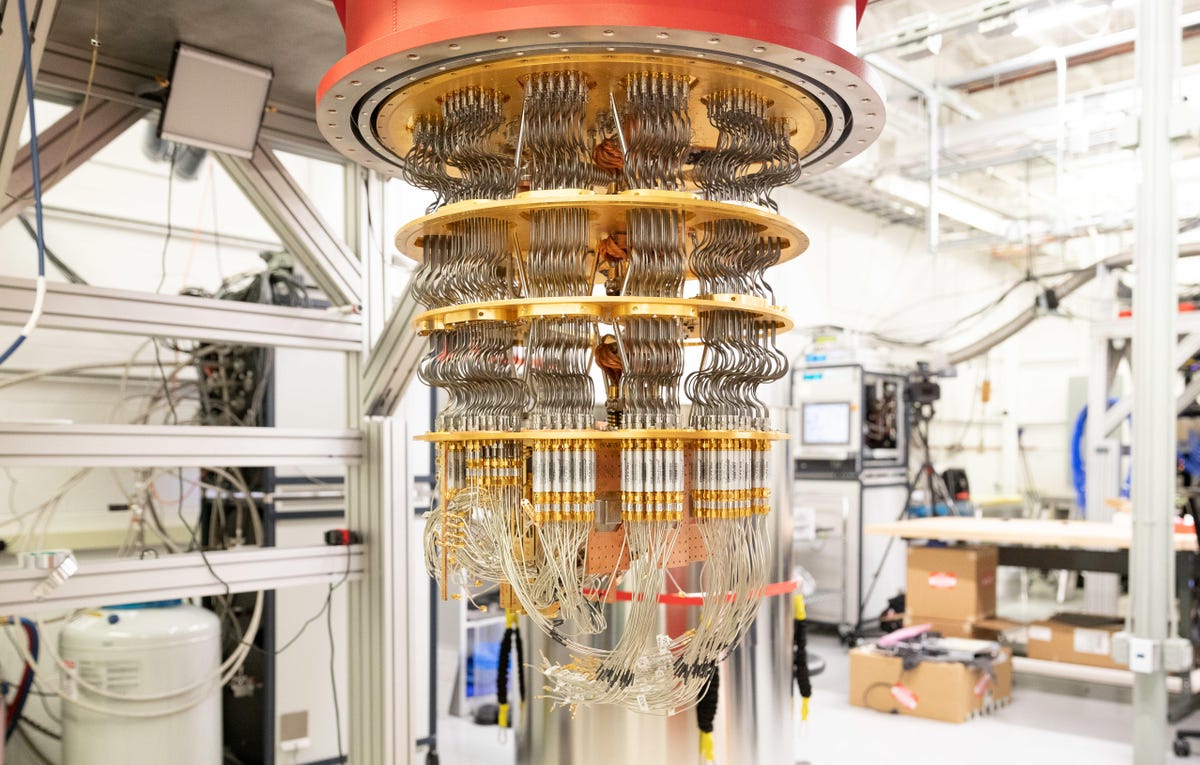
Google quantum computer
A Google quantum computer, shown here without its refrigeration housing, has multiple layers descending from top to bottom, each chilled to a colder temperature. The bottom layer, where the qubit-housing quantum computing chips reside, is only a fraction of a degree above absolute zero.
Google Sycamore quantum computing chip
Google's Sycamore processor features dozens of tiny communication lines to link to the outside world. The chip has 54 qubits, the fundamental unit for storing and processing data in a quantum computer.
Google Sycamore quantum computer
This is the quantum computer powered by Google's 54-qubit Sycamore processor that ran an experiment Google used to demonstrate quantum supremacy. The large cylinder is used to keep the computer extremely cold so outside energy doesn't perturb the super-sensitive qubits.
Google quantum computing sticker
Quantum computing humor: a sticker on a researcher's MacBook touts superposition, one of the weird quantum physics phenomena responsible for quantum computing's abilities.
Google quantum computer
Google's quantum computer uses 216 channels of coaxial cable to communicate with its qubits. Depending on the research under way, some may be unplugged.
Google quantum computing control lines
Google quantum computer control lines stretched out for illustration purposes. The coaxial cables are extremely expensive, costing about $1,000 for each 2-foot segment.
Google quantum computer
Google's quantum computer is fiendishly complex. Each line here transmits electromagnetic signals used to control computation and read data from the qubits that process the data.
Google quantum computer Sycamore chip components
Google builds its Sycamore quantum computing chip out of two parts bonded together. At left is the controller interface to communicate with the outside world; at right is the chip element that houses the qubits that do the data processing. If you look closely, you can see the word "Google" made of tiny iridium dots in between.
Google quantum computer
The top of Google's quantum computer features communication links and equipment to pump liquid helium coolant through the machine.
Google quantum computing manufacturing
You can't buy most quantum computer components off the shelf, so Google designs and assembles them, including its Sycamore chip. Here, researcher Jimmy Chen shows how two separate chips -- one to house 54 qubits and the other to control them -- are bonded together.
Google quantum computing earrings
In a bit of physics humor, Google quantum computing researcher Marissa Giustina wears earrings that are a matched pair of the "bra-ket" notation used in quantum physics: |>
Google quantum computing controller
Google hopes to miniaturize elements like this communication control board used to send signals to qubits. Miniaturization will be necessary as the number of qubits increases.
Google qubit sculpture
Google's Sycamore quantum computing chip has 54 qubits in a two-dimensional array. Running a program on the chip means changing the configuration of the qubits. This sculpture symbolizes the different states of the qubits with different layers as time passes.
Google quantum computing future
Google expects to improve quantum computers dramatically by increasing the number of data-processing qubits and by reducing errors.
Google quantum computing readout system
Special hardware is used to read the state of the qubits at the end of a quantum computing calculation.
Google quantum computing control system
Communicating with a quantum computer's qubits involves sending very tightly controlled electrical pulses, visible here in the oscilliscope display above, down wires that link directly to the quantum computing processor.
Google quantum computing programming
A screen demonstrates the actual data-processing instructions sent to Google's quantum computer.
Google quantum physics logo
Google's quantum computing lab adorns the company logo with the |> notation used in quantum physics.

